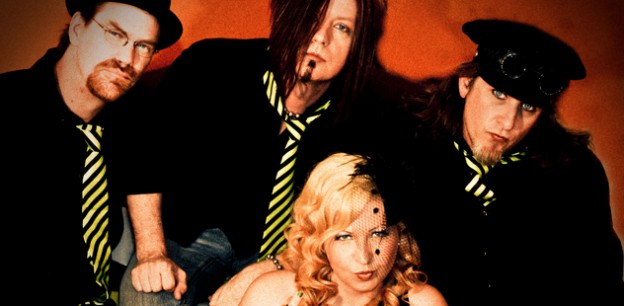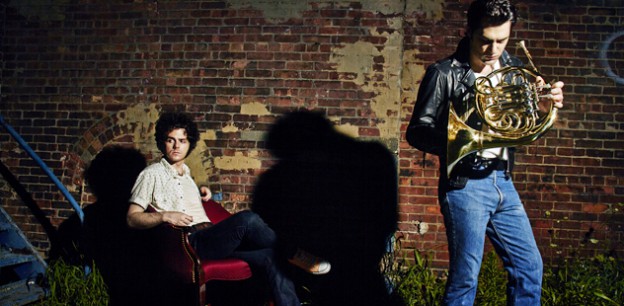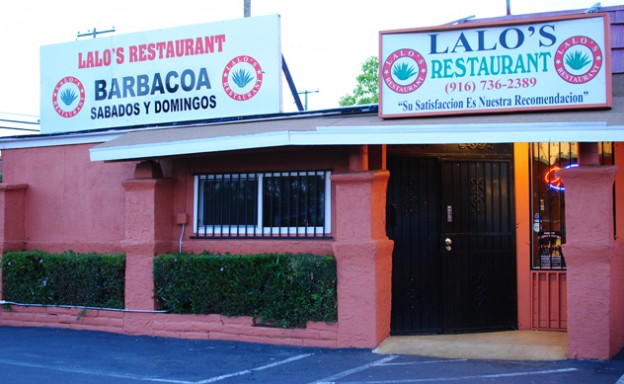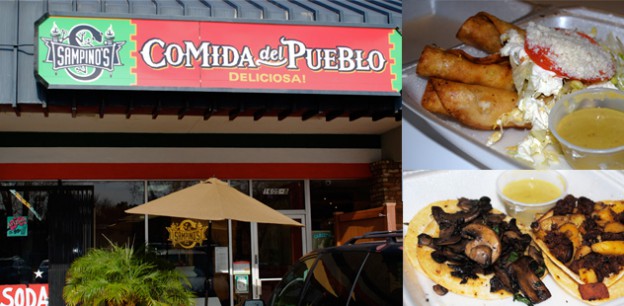Photographer Nicholas Wray showcases his journey to Japan in new exhibition and book
Hailing from the intersection of the Ohio and Licking rivers, former geographer-turned-photographer Nicholas Wray is no stranger to picking up and hitting the open road. From moving from Cincinnati to Sacramento in 2006 to shooting the arid plains of Zion National Park, Wray’s penchant for exploration doesn’t only fuel his artistic passion but feeds his professional endeavors as well.

The proof is in his latest exhibition, simply titled Japan, in which his candid and colorful images of everyday street life in the Land of the Rising Sun adorn the walls of each of the three Insight Coffee Roasters locations. And, at the behest of a friend at the coffee shop, the photos were also assembled into a photo book worthy of adorning the best coffee tables in the world. The series, divided into five sections and scattered between the trio of coffee houses, touches on the many highlights of Wray’s travels: “Architecture,” “Culture,” “Street Life,” “Graffiti” and “Bicycles.”
“Whenever I travel I do this. I have a lot of prints at my studio and tons of photos that just kind of live on my server, so this was the first time that I have printed them super small and priced them super cheap so that people can afford them easily,” Wray explains.

Although the Ohio transplant rolled up to the interview on a motorcycle and sporting a weathered leather jacket, Wray isn’t brash or cocky. Quite the contrary, his quiet demeanor and unassuming nature bucks many of the stereotypes that are typically associated with those working behind the lens. You won’t find him sexually harassing models, attending the incessant parade of networking events that so many artists find themselves engaged in or stroking his own ego.
“This is the first time that I’ve done a show this big, like three coffee shops. I know it’s just coffee shops, it’s not a gallery—I mean I wish I was as cool as someone like Micah Crandall-Bear [and] had Elliott Fouts Gallery showing my stuff every month, but I’m just not that cool,” he says with a wry grin.

Wray’s journey into mastering shutter speeds and F-stops began as his college career was winding down at Northern Kentucky University. After applying for graduation he was advised, a few months shy of claiming his cap and gown, that he needed a minor in order to secure his degree. Uninterested in spending thousands more in man hours and cash, he leafed through the course catalog and it occurred to him that he could revisit his childhood hobby while locking down a minor—photography. He immersed himself in the course work: shooting in black and white film, rolling his own film, editing and enlarging images in the dark room and within a year acquired that prized piece of paper validating his education.

“I think I pretty much took really bad photos up until my very last class,” Wray muses. “That’s when I kind of started doing this street photography. I was in school, working like three jobs and the only time I had [to shoot] was at night. I was out in the snow at night without a tripod just shooting hand-held on film so I made this series of photos of laundromats all over Cincinnati.”
From skateboarders to musicians to commercial products, Wray’s professional portfolio is a robust exploration of the people and places that contribute to the diversity and color of Sacramento. If you’ve attended the annual summer concert series, Concerts in the Park, or witnessed the awesomeness that was this year’s TBD Fest, you may have even landed in the frame of one of his photos. But after years of hustling and struggling to turn his creative pursuits into a viable business, success brought with it an unexpected problem: He was overworked and in desperate need of a break.

“So, I had been taking photos in Sacramento since 2009 and then after [my business] started to take off I was really, really busy for a couple of years,” Wray explains. “I was doing nothing but working—it felt like I was working 18-hour days, seven days a week—so I bought a plane ticket to Tokyo. I wanted to go somewhere super urban and really far away where I would have no understanding of the culture.”
So last October, after booking a ticket and packing his gear—consisting only of a backpack filled with a change of clothes, his camera, a couple of lenses and a laptop computer—Wray set out on a two-week tour of Japan, immersing himself into the culture and shooting everything in sight. Five thousand shots later, Wray had a collection of images depicting shimmering seascapes, people scurrying around the city going about their daily business, bicyclists snaking through traffic and gleaming skyscrapers towering above it all. And while he didn’t speak the language, Wray says his experience with the locals was nothing short of wonderful—from the hostel mother who picked him up on the side of the road to the hospitality of strangers taking him into their homes and feeding him, Wray was in good hands for the entirety of his adventure.

“People were really polite…just really nice people. I guess I shouldn’t be surprised by that—I guess I’m acknowledging that it was a really pleasant place to be,” he admits.
Upon Wray’s return, the images languished on his computer for months before he embarked on the arduous task of wading through the thousands of images captured on his journey and whittling them down into something manageable. Soon a series materialized and Wray decided that it was time for the images to emerge out of their cocoon and blossom out into the world. He presented the idea to his friend, Chris Ryan of Insight Coffee Roasters, to exhibit the work in each of its coffee dens, and after receiving an enthusiastic yes to his proposal the two began planning out the show.

The exhibit is a 145-image romp through the harried streets of Tokyo and Kyoto, the lush, verdant gardens that dot the countryside and everything else in between. Currently, you can find “Culture” at the Pavilions Café, “Street Life” and “Graffiti” at the Capitol Café, and “Bicycles” at the Southside Café. Wray says that the “Architecture” section of Japan will be included in the rotation but because of its sheer volume will make its debut at a later date.
“It’s kind of like a narcissistic pleasure of making a cool photo that someone else will enjoy,” Wray explains. “I think that the coolest thing for me is when someone sees one of my photos and they’re just like, ‘Oh my God, I have to have that!’ I know that they love that photo so much that they want to have it in their house. That’s my reward. It’s not about the money because I’m not making money on selling prints. Like this [show] costs me more than I’m ever going to get off it.”

Now that the exhibit is up, Wray reflects on his role as a member of the Sacramento art community. And while he’s carefully mapping out the location of his next photographic adventure, his time in Japan has reinvigorated the shutterbug.
“The way I look at my job is that I do mostly commercial photography for the market, and people pay me to take cool photos—they pay me to make art for their business,” Wray explains. “So sometimes I do something boring, like some product shot but…I make art all the time, it’s just consumed in a different way. It’s more like people commission me, kind of like a painter. Someone might commission a painter to make a painting, people commission me to make photos for their media.”

Nicholas Wray’s Japan is currently hanging around Sacramento at Insight’s Southside Café (1901 8th Street, Sacramento), Pavilions Café (566 Pavilions Lane, Sacramento) and Capitol Café (1014 10th Street, Sacramento). Wray’s Japan book can be purchased through the artist’s website, Nicholaswray.com.
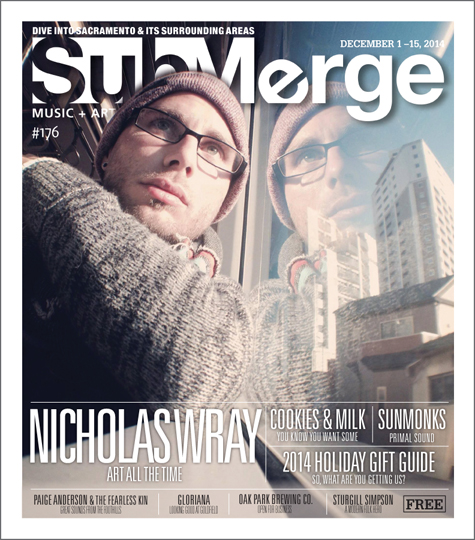
Le Butcherettes’ Frontwoman Teresa Suárez is Impossible to Ignore
If you’ve borne witness to a Le Butcherettes show you know that Teresa Suárez can pull the audience into her lyrical, dark abyss like a black hole pulls a star down into its depths. Once you fall under the unrelenting gravitational pull of the Guadalajaran expat’s alter ego, Teri Gender Bender, there is no escaping the raw fearlessness in her performance.
Take the show at Harlow’s in 2011: After an explosive performance that had the Le Butcherettes frontwoman hurling herself through the crowd, Suárez bolted out of the venue in a self-described music-induced haze and landed straight in the middle of J Street. Just at the precise moment that a Sacramento Police car was cruising down the street.
“That was a crazy coincidence,” Suárez admits. “I snapped out of [the haze] and ran back on stage to continue playing the music, hoping they would just ignore it and drive off. But no, they went into the venue, stopped the show and got me.”
But she was in Sacramento—as soon as the police stopped the show and commandeered Suárez, the crowd spilled out onto the sidewalk and into the street, pleading—no, demanding—the release of the dynamic storyteller, who just moments before had them swooning in adoration of her lyrical barrage. Some people began snapping shots and taking video of the officers questioning Suárez, and ultimately they released her and the show resumed. Admittedly, she was lucky.
“I guess the police felt a little, not threatened, but a little like on the spot in front of all those people,” she says. “If I was by myself I would have gotten taken to the station, at least. So I was lucky people were there to support and say, ‘Hey, no leave her be.’”
Good looking out, Sacto music lovers. Way to rep Suárez and come to her rescue so she could continue the set!

“Yeah, it was so cool,” Suárez says. “Believe me it was lifesaving because my mom would have had a heart attack if she would have found out that I was in jail.”
And that’s what makes Suárez such a dynamic performer: She’s a lioness with the heart of a cub. After having almost been arrested, her first thought was, “What would my mother think?”
Suárez moved with her mother from Guadalajara, Mexico, to Denver, Colorado, as a child—an experience that shaped her multifaceted point of view: one that attacks the institutions of sexism, racism and poverty. It was though her experiences with racism and cultural ignorance, both with Mexican and American people (some Mexicans were prejudiced toward her because her Spanish didn’t have “that Tapatio to it,” as she says, and some Americans called her a “spic” because of her strong accent) that encouraged her to pursue music as a means to rail against injustice. In the end, these experiences in bigotry strengthened her convictions, helping to forge the diamond-plated steel persona that is Teri Gender Bender.
“I learned to love myself. When I was little, growing up in both Guadalajara and Denver, I was made to feel a little ashamed of my roots,” Suárez explains. “Like somehow my cultural difference was a problem for other people…I felt like I was rootless for a while, [but] with music I realized that I’m lucky.”
While social activism is ever-present in the lyrical content of her music and the intensity of her performances, Suárez says that it was her familial influences that forged her punk-rock sensibilities—after all, she grew up listening to Bach: The original anti-establishment artist.
“I’ve been into music my whole life. I started performing in alleys and little bars [when] I was 17 in Guadalajara, Mexico,” Suárez says. “My dad was a huge music fan. He’d come home from work with his Beatles record or a Mozart or a Bach record. He was very open-minded to all kinds of genres.”
As she reflects on the impact that her father had on her education in her development as a musician and poet, Suárez also points to her mother’s somewhat disapproving reaction to their raucous music lessons as a source of inspiration.

“My mom didn’t hate [music], but we’d turn the volume up really loud, and we lived in a small apartment so the neighbors would complain,” she says. “I found that interesting, that music could cause so much chaos. It was a surreal chaos, my mom was like, ‘Oh, Roberto turn that down, turn it down.’ And my dad was like, ‘No, I’m going to turn it up even louder for you wanting it to be down.’ And I was in the middle of it, so I was in bliss—between bliss and fear.”
You can hear the chaos in the music—bliss collides with fear on just about every track in Le Butcherettes’ sonic catalog. The music is passionate, poignant and razor sharp. When Suárez bites into misogyny, greed and cultural apathy, she does so with a venom so sweet that you’re left paralyzed and begging for more. Her delivery is like a bullet wrapped in silk.
On Le Butcherettes’ latest album, Cry Is for the Flies, which was released online May 15, Suárez exudes the infectious energy that makes audiences swoon. But it’s her live performances that catapult the fiery performer into the interstellar realm. Some of her props and antics have included blindfolded mannequins, wearing meat and drenching herself in blood (yes, real pig’s blood, and she’s a vegetarian).
“It’s more of a visual manifestation of [my saying], ‘Argh! People, wake up. Wake up!” she says. “When I go up there [on stage] I just kind of die a little bit, like you’re letting go of that ego and you’re ready to get laughed at. Once you’re up there you just kind of let the energy possess you and you feed off of the people that are there.”
Suárez is certainly bold in her convictions, but it goes beyond that; she believes that musicians should be leaders. Leading the discussion on issues that many are afraid or unwilling to address. As Suárez gears up for her return to the scene of the 2011 crime, when Le Butcherettes plays Assembly on Oct. 15, 2014, she’s quick to give props to one of the local leaders in the Sacramento music community who she thinks is pretty badass.
“Zach Hill, he’s one of my downright favorites. He’s multi-talented, he’s a great composer, he’s not just a drummer, but he’s an artist, he’s a well-rounded artist,” she gushes. “I think musicians nowadays are more focused on their image than wanting to be a leader, and I think Zach Hill breaks that [mold]. He says ‘Fuck you!’ to the image and he breaks the rules. I think in a way he’s becoming a leader, like he’s sending a message that the artist has had enough of being a slave to the music industry and I think that’s what he represents.”
Just remember, if do you check out the Le Butcherettes set at Assembly, be sure that your smart phone is fully charged—it’s sure to be a performance full of surprises and you just may need to document the frenzy that is sure to erupt. Sans cops, hopefully.
As of press time Le Butcherettes was scheduled to play Assembly Music Hall in Sacramento on Oct. 15, 2014, in support of the Melvins, but the band has since dropped off the bill. We’ll update our readers when Le Butcherettes schedules another Sacramento show. Go see The Melvins still! Tickets are $18 and can be purchased at Assemblymusichall.com, Dimple Records or Armadillo Music in Davis. Le Butcherettes’ Cry Is for the Flies was recently given a physical CD/LP release on Sept. 16, 2014 via Ipecac Recordings.
The Kimberly Trip are All Outta Bubblegum
Love at first sight, a whirlwind romance and rock ‘n’ roll…Ah, the recipe for matrimonial bliss. At least for Kimberlina and Jeffry Wynne Prince, two-fourths of The Kimberly Trip, the Sacramento band that combines snarky lyrics, spacey guitar hooks, synth-laden tracks and soaring female vocals into a singular sonic experience.
But don’t let the seriousness of their musicianship fool you. It is a source of pride that The Trip doesn’t take itself too seriously. Submerge recently sat down with the lovebirds to talk about the band’s evolving sound, what inspires their music and the awesome power of unicorns (the band’s sixth studio release is titled Unicorns, Glitter, & Heartbreak, after all).
“Yes, [unicorns] are magic,” Kimberlina, the band’s vocalist, jokes. “See, I like to refer to that album as UGH, because that’s what it spells out: U, G, H. And it’s just quicker—it saves all that mouth work, but I do like unicorns, too.”
And the part about heartbreak, you ask?
“Because unicorns aren’t real,” Kimberlina says with a wink and a nod.
Not one to let the interview veer off onto that rainbow path where mythical creatures roam, Prince chimes in with a more profound explanation of the album’s genesis.
“When I named the album, I noticed the songs pointed to three kinds of things going on in life,” he explains. “One was like shiny optimism, which is kind of like glitter. One is just fantasizing about improving your life and the other is about having your heart broken. So it just seemed like unicorns, glitter and heartbreak encompassed, in a conceptual way, the songs.”
In the span of 13 years, The Kimberly Trip (which also includes Bractune on drums and bassist Michaelandrew) have cut eight albums, thrown legendary DIY warehouse shows, been named Songwriters of the Year by the West Coast Songwriters Association, surpassed 100,000 digital downloads on their website and will commemorate their 500th show on the Concerts in the Park stage on July 25, 2014—a show that coincides with the band’s CD release party for I’m All Outta Bubblegum, which Prince explains as an album of jumbled fragments that is as far removed from the classic Trip vibe as a vibe can get.
“It’s got tons of keyboards and technical elements really outside of our wheelhouse [of music], so we thought it would be interesting to kind of dovetail with the Concerts in the Park, giving our fans a reason to come out,” Prince explains.
While the musical juggernaut chugs on, it’s fair to say that all of these accolades, accomplishments and awards would be but a distant dream if it weren’t for Prince’s tenacity in winning Kimberlina’s heart at a gig on the Sunset Strip. Where else, right?
“In fact, the way I picked up on her was I booked a gig in Southern California in Hollywood, closer to where she lived so I could bribe her to come see us,” Prince explains. “Because I knew once she saw the rockstarness that was happening on stage she would be mine.”
“And that is totally how it went down,” Kimberlina confirms. “So, it’s in Hollywood on Sunset Strip, you know, super premium place to have a gig, right, and he comes out on stage and in the middle of Hollywood, shouts out, ‘Hello, Lodi!’”
“She was the only one that got the joke,” Prince says with a grin.
And that’s all it took. He had ensnared Kimberlina into his web of rock stardom. A quick 10 months later the two were man and wife, and living blissfully in their home and studio in Fair Oaks. But it wasn’t until months later that Prince happened upon her vocal prowess.
“I knew she’d been a singer…but I’d never heard her sing,” Prince says. “So, I hadn’t heard her sing until two months after we got married. She heard me working on a song and she came in and she goes, ‘I have a harmony idea,’ and she sang what she was hearing and I kind of lost my mind over what she sounded like, so we formed the band that day.”
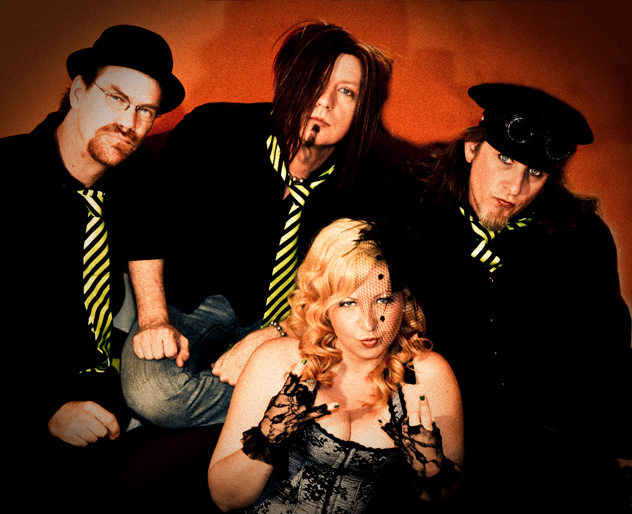
While Prince was blown away by his newly betrothed’s vocal range and beauty, it wasn’t until their roommate at the time, Bractune, who has been making music with Prince since 1984, came home and confirmed they had stumbled upon vocal gold.
“More importantly, she impressed our drummer Bractune,” Prince says. “I had recorded what she had done, and I played for him and he was like, ‘Who the hell is this?’ It’s Kim. ‘That’s ridiculous, there’s our singer.’”
From there, their sound and vision solidified. Committed to making their wry, tongue-in-cheek variety of music on their own terms, just last year they ditched the major-label system and began releasing their music solely on the band website. Moreover, they could fully embrace their songwriting process, which always begins with a song title, Prince explains.
The duo also produces material for TV and films, allowing the band to fully explore its musical vision.
“Back when we started in 2001, music seemed to be really serious and we wanted to be different,” he explains. “When we first started, Kim had mentioned in the early songwriting sessions that there’s a certain point where it becomes OK to laugh at yourself, and when you laugh at yourself life becomes better.”
Kimberlina nods emphatically in agreement as her gaze falls lovingly on her partner in music.
“I mean, I’m gonna just talk in clichés here, but there’s an idea of giving a voice to the voiceless and having a sense of humor about yourself and, at its core, I think music and art in general is a way to help people feel their feelings, or to express their feelings,” she says.
But not letting her trademark smart-ass nature off the hook, she continues.
“I know, I’m way over-thinking the pop-y crap that we do but, yeah, that’s our voice,” she adds with a wry grin drawn on her cherry-hued lips.
“And in our socially dysfunctional microcosm of dysfunction, there are infinite song titles,” Prince adds, riffing off Kimberlina’s vibe of sarcasm and snark.
Because the song title is king in Prince’s world. And, he’ll argue, what’s the use of a badass song if its title isn’t an incendiary send-up of this kooky world we live in of glittery unicorns grieving over lost lovers?
The Kimberly Trip’s CD Release Show for I’m All Outta Bubble Gum is a free, all-ages Concert in the Park show at Cesar Chavez Plaza July 25, 2014. They’ll be joined by the Brodys, Pointdexter and more. For more info, visit Kimberlytrip.com or Downtownsac.org/events/concerts-in-the-park.

The Perlick-Molinari Brothers Break the Boundaries of the Horn Section with French Horn Rebellion
What happens when you cross a classically trained French horn player with a dude who knows how to drop mad hot beats? Band geeks gone wild, of course!
The self-proclaimed “geeks,” brothers Robert and David Perlick-Molinari, founded French Horn Rebellion in 2007. The duo was inspired to explore their musical yearnings with a brand of plucky, ’80s-inspired electro-pop after producing MGMT’s “Time to Pretend.” Yes, that MGMT hit that reached No. 3 on Rolling Stone’s Best Songs of 2008.
And while FHR is a Brooklyn-based outfit by way of Milwaukee, Wisconsin, they’ve spent plenty of time in Sacramento: last December they rocked the house at LowBrau, they recently wrapped up a collaboration with the Sacramento Ballet and current indie-rock darlings HAERTS for the video “Swing Into It” and in July they’ll make an appearance at THIS, the MARRS Building corridor’s Second Saturday street party. Suffice to say, FHR’s got nothing but love for Sacramento.
“Well, I think it’s just the scene that’s going on in Sacramento, and from what I’ve noticed around the country, it really just takes a couple people to bring people together,” Robert, the younger Perlick-Molinari brother, explained to Submerge in a recent phone interview. “There’s a trend across the United States, which I’ve noticed, that a lot of towns are going local, getting local food, local restaurants, not chains—chains aren’t valued as much as they used to be, and places like LowBrau are kind of like the trend of the future, so to speak.”
Robert received an early education in music at the age of seven when his older brother TJ, now a lawyer for the family custom beer tap business in Wisconsin, thrust the French horn upon him, which he embraced feverishly. By the time he was in college he was a full-on musical impresario. But it was when he spent the summer interning at his brother David’s music studio in New York that he realized he wanted to rebel against the notion that classical musicians were bound to the orchestra pit.
“Rebellion is to say, that hey, French horn players around the world, you don’t have to sit in an orchestra, in the horn section and play music that’s on the page in front of you,” Robert explains. “We can do anything—we have way more power than we think. [So, I thought] yeah, I don’t really want to play Mahler anymore. I don’t want to listen to a conductor. I’m just gonna go make dance beats with my friends, and that’s French Horn Rebellion.”
A mix of driving, electronic beats and a hefty serving of camp and wry humor, FHR’s music isn’t your garden variety dance music. The brothers have dubbed their evolving sound as Next Jack Swing—funky with a classical music twist. Because when you’ve played the French horn since you were 7 years old, ascended the ranks in the pit to first chair French horn player as a sophomore in the Northwestern University Symphony Orchestra and have had the honor of fisting your horn (yes, a common term for achieving certain notes by inserting your fist into the bottom of the horn’s shaft) next to some of the best in the Civic Orchestra of Chicago, it’s not something that is easily forsaken for pop-music notoriety.
“I still play in some community groups, for sure, to feed the urge,” Robert explains. “But, at least playing at a high level, I guess I do miss that—that was pretty amazing, like playing with the Chicago Civic Orchestra was a real experience. But what you trade off for that is, [for instance], I was deejaying in Washington, D.C. and I’m playing my French horn and like 300 people are losing their minds on dance music; dancing and having fun. I think that’s so much more visceral and more fun than classical music, which is usually older people in a quiet room watching some guys in a tuxedo.”
Robert is getting used to this gig—spinning records to a heaving crowd of dance freaks, busting out his French horn periodically to ignite the crowd into a music-induced frenzy. But these days it’s largely a one-Perlick-Molinari operation.
“We don’t actually go on tour together anymore,” Robert explains of his brother’s absence from the live shows. “He’s a full-on studio man now. So, he…makes the beats with me, but he doesn’t actually participate in the live shows anymore.”
In between running a studio and a record label, managing the band business, preparing for a 26-date tour of North America and recording a new single with Spencer Ludwig, the trumpet player in the group Capital Cities who also frequently plays alongside DJs, the brothers Perlick-Molinari are gearing up to record a compilation album while hashing out all of those details around a musical war room table involving the brothers and a new management company.
“We’re in a little bit of a strategic war zone, of how we’re going to release this music at this point,” Robert explains sheepishly. “I can’t give any specific dates, but we will have dates soon.”
FHR is slated to play THIS Second Saturday Block Party on July 12, 2014 with Goldroom, Sunmonks, Gentleman Surfer, Be Calm Honcho, DJ Shaun Slaughter and Adam Jay. For more info, visit Facebook.com/frenchhornrebellion or Facebook.com/thismidtown.

DLRN Release the first half of Neon Noir
Shit is about to get weird, folks—Fear and Loathing is about to descend upon Sacramento with a sonic boom reminiscent of the drug-induced adventures shared by a famed Gonzo journalist and his faithful companion.
No, Hunter S. Thompson hasn’t canceled his self-imposed exile from the realm of the living to wreak havoc on our City of Trees; rather, “Fear and Loathing” is the inspiration and title of one of the tracks off the forthcoming release from the hip-hop duo DLRN. And if you’ve checked out the video, a slick and sexy visual experience that includes plenty of booze, a hint of the drug culture that made Thompson so famous and the artists donning animal masks, the inspiration is clearly entrenched in the Gonzo spirit.
“I think, in context of this particular song, the vivid images from Fear and Loathing in Las Vegas, and the really dark, abyss-like backdrop of [Thompson’s] stay there, helped me contextualize my own dark experimenting in that city,” says Sean LaMarr, DLRN’s vocal impresario.
Neon Noir, an LP segmented into two parts (part one of which is set to drop June 3, 2014 on the Waaga Records label with a limited-run cassette tape offering—yes, you heard right, that plastic rectangular mechanism for inducing eargasms—as well as a digital version for all of you who ditched your cassette players when CDs took over the music world), is the continuation of a narrative arc that LaMarr has been developing since the group formed six years ago.
“Neon Noir was a full album that got broken into two albums,” LaMarr explains. “In part because [of] Waaga—their strength is really electronic and electronica music, but they really gravitated toward our songs that were in that vein. So, [there’s an] A side and a B side of the project where one is more electronically charged and the other is more hip-hop.”
Forged in the fires of the electro-synthed-out vibe that seems to be permeating just about every facet of Sacramento’s musical landscape these days, DLRN’s LaMarr and production prodigy Jon Reyes are storytellers in the deepest sense of the word—often taking inspiration from literary legends like Thompson and Kurt Vonnegut.
“We have a great appreciation for the written word. Probably more than the spoken word,” LaMarr explains. “The line in Stevie’s hook [on “Fear and Loathing”] ‘Everything is beautiful and nothing ever hurt at all’ is a Vonnegut reference, too.”
“DLRN is really just a collection of both mine and Sean’s experiences, and our interpretation of what this world is,” Reyes continues. “From the movies we consume to the music we listen to, we put it all back through our art. Really it’s just an incubator of all of our ideas; trying to share with the world how we see things.”
The duo’s love for storytelling is also explored through their videos, the majority of which have been conceptualized and directed by Sami Abdou of Upper Cloud Media. He’s the mastermind behind the videos for the tracks “Dear Langston,” “Reset,” “Good Company” and “Fear and Loathing.”
“We take a lot of time and energy, and you know, really try to give the best product we can—visually and with the music itself,” LaMarr says. “Hopefully they complement each other the right way.”
While Reyes, born and raised in Sacramento, has relocated to the Bay Area, the hip-hop twosome’s love for Sacto is clear—local lyricists and vocalists Young Aundee, Leia Layus, Nami Ramo and Stevie Nader (who is also in the video for “Fear and Loathing”) also make guest appearances on Neon Noir. The visual exploration of their sound also provides a purview into the soul of Sacramento itself. Iconic Sacto landmarks are littered throughout the video for “Dear Langston”—the city’s skyline, and even the Old Ironsides sign, makes a cameo as LaMarr strolls down the grid’s streets, pouring his heart out in song.
“Sacramento—and we both feel this way—is an amazing place to curate and create art,” LaMarr says. “I think some of it is partially out of desperation, being like there’s not, at least when I was coming up, there wasn’t much to do until you were a certain age, so the outlet of creating and making art was paramount [to] my development as a person.”
The duo, who has known each other since high school, began their artistic journey as a part of an art collective that included dancers, spoken-word artists and graffiti writers. And while the collective wasn’t a formal organization, the close-knit group of friends who were collectively exploring their creativity in an interactive and supportive environment served as the catalyst for their current creative endeavors.
“When we first started creating music we were very into what would be considered alternative hip-hop,” Reyes says. “I think just the way music has evolved our sound has to evolve as well. I think with every project, we try to find different ways to put things together. I find I’m most creative when I’m learning new things.”
As LaMarr and Reyes gear up for the album’s release and a June 4 release party at Dive Bar as a part of a South by Southwest-inspired block party on the K Street Mall, their latest exploration of this narrative arc delves into that Gonzo sensibility, but keeps that hip-hop swagger.
“With ‘Fear and Loathing,’ [it’s] the story of me going on a friend’s bachelor party in Vegas and just my interactions with people in those moments, and walking down hallways and those beautiful hotels and feeling super lonely,” LaMarr explains. “It just was a moment when I was like, ‘Wow everybody comes out here on some sort of conquest and at the end of the day [we’re all] just wandering these halls.”
Dive Bar is hosting DLRN’s record release party during the Block Party on Wednesday, June 4. Show starts at 10 p.m., 21-and-over. Visit Facebook.com/DLRNmusic for more info.

Lalo’s Restaurant
5063 24th Street • Sacramento
A sure thing, a safe bet—these concepts typically hold water. Death and taxes instantly come to mind.
But, in the restaurant world, even a sure thing can erode into disappointment, which was recently my experience with Lalo’s Restaurant, a Mexican restaurant tucked in the corner of a mini mall near Sacramento City College.
I first became acquainted with Lalo’s when some of the homies introduced me to it nearly 10 years ago. Its laidback style was comforting, the food proved tasty, the prices were reasonable and the menu boasted a selection of ingredients and dishes that I’d rarely seen in other Mexican joints—huitlacoche (corn smut) and flor de calabaza (squash blossom) quesadillas but namely, the molcajete.
The molcajete is the Mexican version of the mortar and pestle. But at Lalo’s, it’s a simmering volcanic eruption of meaty goodness that includes chicken, steak and chorizo, floating in a sea of spicy green salsa, topped with a glorious crown of mozzarella cheese and nopal (cactus) draped along the lip of the stone vessel. That evening I opted for the flor de calabaza quesadilla, but when my friend was presented with the molcajete, the sizzling pot of goodies, I knew I had not chosen wisely.
Noticing the food-lust in my gaze, he was nice enough to offer me a taste. A taste I never forgot.

Recently, when afforded the opportunity to revisit this humble abode of Mexican food delights, I regaled its qualities to my dining companion for the evening. Longing for that molcajete, I boasted. I bragged. I convinced. And so we went.
The restaurant was just as I remembered: Brightly painted walls in yellow and orange adorned with a smattering of Mexican art, and a trio of self-serve beverage dispensers with aguas frescas and horchata. And while you won’t find any cervezas or margaritas on the menu, there are plenty of other options like orange, carrot and beet juice, banana, mango and papaya milkshakes and Mexican Coca Cola in that familiar glass bottle.
At the counter, where it’s customary to place your order, but not required, as they do offer table service, my salivary glands were in overdrive. The menu is robust—tacos on the cheap at $1.25 a pop, tortas, quesadillas, sopes, enchiladas, burritos and tamales. But the abundance doesn’t end there because the selection of innards with which to fill your vessel of choice is plentiful. From the typical (grilled steak, pork, chicken, cheese, potato, mushrooms and beef brisket) to the adventurous (pork esophagus, beef head, tongue and tripe) there’s something for everyone.
I knew I had to have that molcajete, but faced with so many choices, I opted for their street tacos as an accompaniment and ordered two: carnitas and lengua.

As someone who has happily ingested lengua (that’s right kids, tongue), and who also judges every Mexican eatery by the quality of its carnitas, I joyfully placed my order. My homegirl from the barrio (OK, I can say that because she’s from East L.A.) decided to take on their chile relleno. By the way, her grandmother is from New Mexico where the real chile comes from—the Hatch chile, so she knows her way around a chile.
Our server greeted us with a tasty offering of homemade chips and a duo of fresh tomato salsa, a mild version and its spicy counterpart. When she returned with the goods, we dove in with gusto. The tacos received mixed reviews—the carnitas stood up to any of the best in town, but the lengua, while tender, had morsels that were a bit too fatty.
Disappointed, but not discouraged, I took a few bites of homegirl’s relleno, which was accompanied by the requisite side, rice and beans. While I have experienced a few soggy, withered and bland chile rellenos in my time, this was simply unremarkable. It wasn’t soggy, nor withered; to the contrary the chile still had a bit of bite to it, which I actually like, but it was smothered in a sauce that neither I, nor my companion, could place as Mexican.
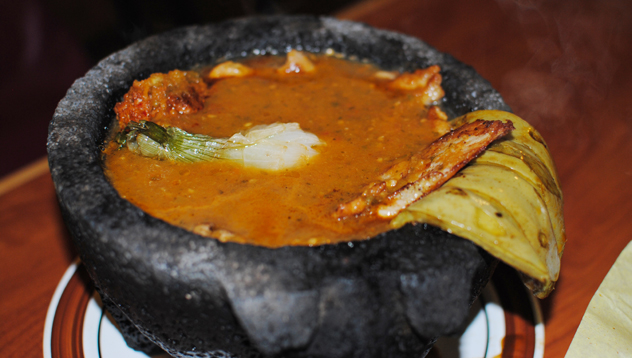
But, this was quickly forgotten when that familiar bubbling cauldron of molcajete arrived at the table. The smoky aroma and the steam rising from its meaty contents excited me and I immediately recalled that moment all of those years ago when I looked across the table at my friend who devoured its soupy goodness with glee.
As soon as it hit my lips, I knew something was amiss. While it was good, it wasn’t great. The meat was tender and the sauce still had that luscious, spicy flavor I remembered, but it had lost something. Or, rather, something had been added in abundance: salt. I had a few bites, and then sadly gazed at my companion, bagged up the remains and sulked to car.
Perhaps they were having an off night. And while I may give them another opportunity to impress my palate as they had done all those years ago, I suppose nothing is a sure thing in this world.
Sampino’s Comida del Pueblo
1605 F Street • Sacramento
It has been said that some of the best food can be found in “hole-in-the-wall” spots that offer little more than, well, the food itself. These low-key dining establishments typically boast bare-bones interiors and a penchant for serving up dishes that keep its patrons coming back, again, and again, and again. The latest eatery to adopt this philosophy is Sampino’s Comida del Pueblo, a small restaurant in a midtown strip mall.
Serving up a fiesta for the belly that even Lucha Libre would appreciate, you won’t find anything but simply prepared Mexican fare at Comida del Pueblo—no Asian, or even Italian mash-ups here, the latter of which one might suspect since the joint is operated by Gabriela Sampino, the daughter-in-law of Bill Sampino who owns an Italian delicatessen, Sampino’s Towne Foods, next door.
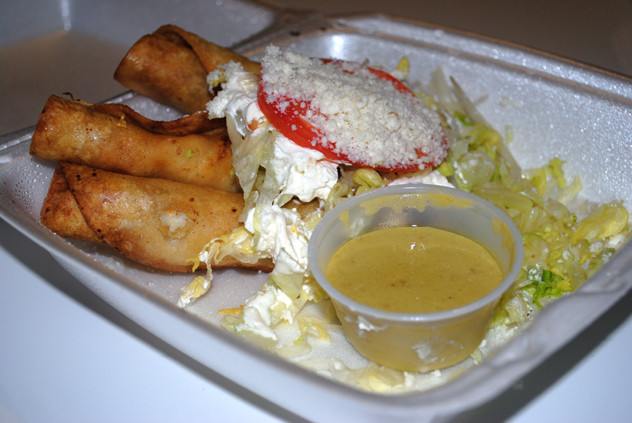
As simple as the food is, the interior space one-ups the no-fuss, no-muss philosophy of the menu. You won’t find any indoor seating in what is more of a hallway than a dining room, and residing outside of its modest confines, a small, solitary table where one lucky diner, or two depending on how big the meal is, can enjoy the fruits of Sampino’s labor. While Comida del Pueblo is more of a takeout spot than a full-fledged eatery, don’t be fooled by the white Styrofoam vessels, the food is legit.
Entering the long narrow passageway that is the main ordering area, the aroma of freshly made tortillas greets each guest like a warm hug. For being new to the game, and operating in an extremely tight work space, the staff seems to have their service routine on lock—on a recent visit during the afternoon lunch rush, the food came out of the small kitchen quickly, but not too fast to suggest that the goods weren’t being prepared to order.
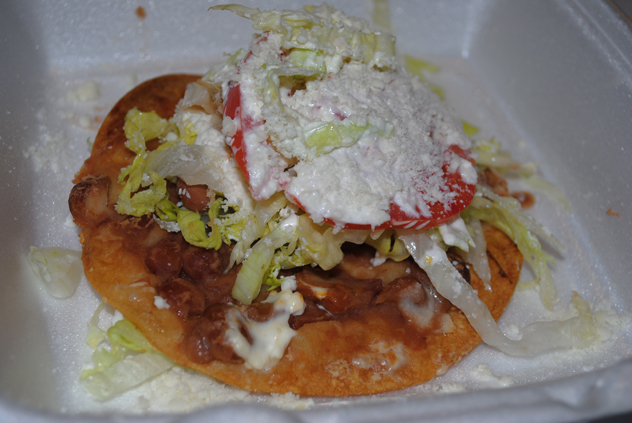
Speaking of the goods, while the menu features classic and familiar dishes, each dish I experienced—and mind you, I went in on a serious Mexican-food binge in order to provide a robust commentary on the food here—had a distinct flavor and freshness that is atypical of quick-serve Mexican joints. The menu includes several prepared items that are served from the hot display case dripping with steam from the fresh tamales and roasted chicken.
Now, the reason I let loose my inner fat kid to experience all that Comida del Pueblo has to offer is simply because of the ridiculously low price point of the a la carte section of the menu—$1.65 to $3.25. With prices like this, it made my insanely large and gluttonous order necessary: three tacos, two tamales, six flautas (because I had to try both the chicken and potato, right?), a bean tostada and two burritos. OK, full disclosure; I did share each item with a dining partner-in-crime.
The true test of a Mexican restaurant has got to be its carnitas, that quintessential Mexican dish boasting tender, porky goodness. Happily, Comida del Pueblo’s offering did not disappoint. We went for the tacos instead of the combination plate, just to keep our guts in check in preparation of the mountain of food we were about to consume. The tender meat was moist and adorned with those trademark—and very necessary—crispy tendrils and piled atop a duo of mini corn tortillas.
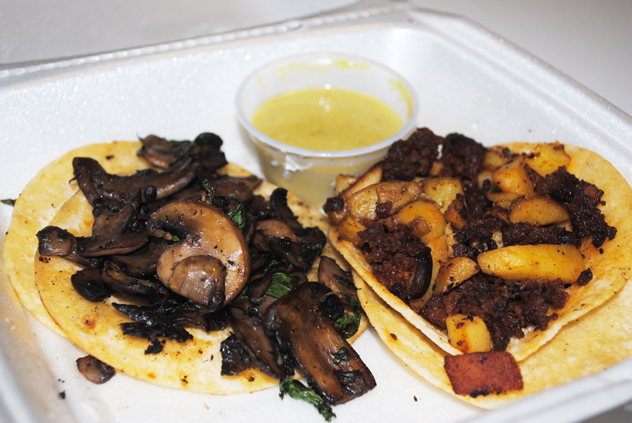
The next items on order: the taco course, as I like to call it. The chorizo and potato tacos garnered rave reviews from my dining companion, and I couldn’t agree with the assessment more: the tender Mexican-style chorizo was in perfect harmony with its companion of crispy potato cubes. The chorizo held the perfect level of spice, while the potatoes added a nice, surprising texture and bite next to the tender crumbles of pork cheek.
The mushroom taco was another delightful surprise. For those who have given up the flesh, well, animal flesh—that is, the mushrooms were hearty enough to satisfy the most devout carnivore. An earthy, simple preparation of sautéed mushrooms accompanied by a smattering of cilantro provided the perfect veggie-fied counter to our meat-laden feast. Again, like the carnitas, chorizo and potato tacos, the mini corn tortilla played host to the main attraction.
The taco course was concluded, and most gloriously so, with a crispy-shelled taco that cradled a mound of shredded chicken sprinkled with a confetti of crispy iceberg lettuce and Cotija cheese. While the perfectly crispy taco shell was a nice change-up from the previous soft-shelled tacos, the star of this show was the chicken itself. Bathed in a restrained sauce of chipotle peppers in adobo, the chicken was a smoky compliment to the tangy cheese.
The potato flautas, while providing a nice intermission between the taco and tamale course, fell a little flat, but only because the potato innards were subtly seasoned, which we surmised to be because of the richness of its toppings: a thick swath of Mexican crema and Cotija cheese. Luckily, the salsas at Comida del Pueblo, which are served with just about every a la carte item, provide a punchy wallop of flavor and spice. A word to the timid, however, the salsas are not for the faint of tongue.

With our bellies filled, we trudged onward—note: it is possible to develop a food high. Trust. The tamales weren’t overly stuffed, much to the chagrin of my companion, but were nestled in the most delicate and airy masa cocoon I have ever experienced. The burritos, however, were gargantuan in size and I could only muster a couple of bites of the cheesy, tender grilled chicken and pepper offering.
In total, while Sampino’s Comida del Pueblo has only been open since September 2013, it’s well worth checking out. It’s easy on the pocket and offers a simple and fresh take on the old Mexican standby. Just be sure to get there before 5 p.m., because they don’t do dinner.
Sampino’s is open Monday through Friday, 11 am to 5 pm. Call 441-2361 for more info.
The Flaming Lips’ Steven Drozd on Longevity, Acting and Terror
Photo by J. Michelle Martin Coyne
Do you realize that The Flaming Lips have been playing their brand of psychedelic rock for 30 years? That’s no small feat for a kooky band from Oklahoma City that’s thriving in a business so fickle that new musicians are first heralded as the second coming, then quickly wear out their welcomes as they’re chewed up and spat out by the same adoring fans and record labels. From their spaced-out musical compositions and a circus-like production that is the hallmark of their live shows, which has included a flock of costumed dancers gyrating around the stage while being showered with multicolored flecks of confetti as frontman Wayne Coyne floated atop the audience in bubble built for a man-sized hamster, the band is an unpredictable force in the music business. With the frenetic pace at which they operate—they’ve released not one, but two records this year: The Terror, the band’s 13th studio album; and Peace Sword, an EP inspired by the sci-fi film Enders Game; and have a dizzying tour schedule—it’s no wonder Q magazine named them one of the 50 bands to see before you die in 2002. Submerge talked to the Lips’ Steven Drozd about staying relevant in the music industry, their new “subdued” stage show and how the heady days of the billionaire rock god is a relic of the past.
What’s the band’s secret to longevity?
I’ve been in the band for 22 years, [and] I think one thing that actually worked for us was not being too successful too early. I think if the band had been more successful, if the band had a big hit their second record in, [or] if we’d had a big hit when I joined the band, things could have gone the other way. I think not having any big success until much later in the band’s career worked in our favor. I think another thing is just being interested in new music, instead of a lot of bands [where] they get something that works for them and they just stick with that formula. I think for us we’re just trying to keep changing what we’re doing.
The Terror has been described as the Lips’ darkest album to date. How does this new, darker material translate into the live show?
It took a little while. Some of the first shows where we were playing The Terror stuff it was kind of rough. I think we were just going on the excitement of doing a whole new show…but the first few shows were chaotic in a way, meaning we hadn’t found the right dynamic for some of those songs. We’re not doing the big party balloons anymore, Wayne’s not doing the space bubble and we don’t have people dancing on stage, but it’s a different kind of intensity. We still have confetti, but it’s black confetti that gets shot out into the crowd. We still have a crazy light show, but it’s crazy in a different way.
It’s been written that the band is at the peak of its creative career, where do you go from here?
I don’t know, I think that in some ways people might have thought we peaked after The Soft Bulletin and where were we going to go from that. Then some people think [we peaked] after Embryonic. I just hope that if we keep being interested in music and keep trying new things that even if we fail commercially at least we can feel like we’re trying something new. Maybe people will think that we’re at some kind of creative summit, [but] I guess I don’t think about that kind of stuff really. I think that if I did it would drive me crazy.
Tell me how your side project, the Mutating Cell Ensemble, came about?
I just had this thing in my head for a little while, I always had these little rhythmic and music theory things that were percolating in my head. We only did one show, but I want to do another one. I just had this musical idea I wanted to try. I knew it wouldn’t be with the Flaming Lips and I wanted to get just a group of musicians of different calibers, but people that would be interested in trying this “experiment.” I got a group of music students from the [Academy Of Contemporary Music] here in Oklahoma City and I told them that we’re basically going to be playing the same two-note riff and see what happens if we play it for an hour. We did a performance of it and I thought it was incredible. I felt high when we were done, it was so intense.
I know you’ve dabbled in acting before, any plans to delve more into that medium?
Oh…that Christmas on Mars thing. I still apologize to Wayne for that because when he started working on it, I was like, “You know in sixth and seventh grade I was in drama and I did really well in drama class,” and so he decided to make me the Major Syrtis character and now whenever I do watch it I’m just like, “Oh, god the acting is so bad.” It’s so bad that it’s interesting, you know. If I was given another chance I would definitely try much harder and I’d be more committed to the project. I wouldn’t rule it out; if anyone wants me to try do any acting for them I’d be glad to do it.
If you had one word to describe the evolution of The Flaming Lips what would it be and why?
Uncanny, because for all of the things we thought we had control over, I think for every one of those there were things we had no control over that actually worked in our favor. I think it’s us letting things happen, and letting that kind of guide us in some ways really benefitted us in a big way.
Speaking of the music industry, it appears to be at a weird crossroad. What do you think about where the industry is going and sites like Spotify?
I have no problem with Spotify, I really don’t. I guess for me the thing is I just can’t accept that there’s not going to be any huge cultural shifts like there used to be. To me, that’s a bummer to think about that. It’s just a different world we live in now and to me it’s just a bummer that whole cultural, underground big shift can’t happen again, and I really believe it won’t happen again.
The Flaming Lips were scheduled to headline the Last Chair Music Festival at Squaw Valley Jan. 9 – 11, 2014 but literally HOURS before we went to press, it was announced the gig was postponed until further notice. To keep up on all things Flaming Lips, go to Flaminglips.com.
Andy’s Candy Apothecary Has Just What the Doctor Ordered
Photos by Nicholas Wray
Most kids daydream about owning their own candy store—an unlimited supply of sugary treats, the euphoria of a candy-induced sugar high, the unadulterated bliss that comes from the cornucopia of lollipops, gum drops and gummy bears at your complete disposal.
For Andy Paul, that childhood dream came true when he beat out nearly 50 other budding entrepreneurs after the Downtown Sacramento Foundation, a sister organization to the Downtown Sacramento Partnership, announced him as the winner of its Calling All Dreamers contest in July.
“I’ve always been interested in good food and I’ve always kind of been a sweets freak,” Paul says. “So, growing up, I was probably a little more into candy than your average kid and then even as an adult I’d always find myself looking for a candy shop wherever I went.”
Winning the competition (a prize worth $135,000 that includes free rent for a year; business support assistance including advertising, contractor build out assistance, graphic design, strategic marketing support; and legal and accounting services) allowed Paul to realize his confectionery aspirations and open Andy’s Candy Apothecary.
“It had been sort of a little pipe dream, so the contest was perfect,” Paul says. “What actually happened was one of our friends mentioned it and then we applied. Somewhere in the middle [of the process] we were like, ‘Even if we don’t win, we’re going to start this business,’ but it was really because of this one person.”
At the apothecary, Paul’s vision is to be a candy curator of sorts. By providing a wide variety of confections to suit the young, as well as the young at heart, he is able to prescribe the perfect remedy for his customer’s sweet tooth based on their preferences. The only side-effect is happiness, he says.
“We do have a wide variety, we’re really not just one thing, and that’s really important to me,” Paul explains. “There’s kind of something for everybody, and that’s probably how we happened upon the apothecary theme. We didn’t happen upon the word prescribing right away, but we realized that’s kind of what it is.”
The shop, which opened Dec. 13, 2013, lures you in with the promise of high-quality yet fun candies. The design aesthetic is a bit like Willy Wonka meets an upscale chocolatier, with a sprinkling of old-world apothecary touches: The entryway wall is lined with chocolate bars—a wall of chocolate that would make Wonka proud. The centerpiece of the store is a large counter where most of the homemade premium chocolate lives. And behind the counter, a display of shelves housing clear jars is filled with all the different kinds of colorful candy that Paul has sourced from all over the world—the design inspiration of which came from a present he received from his wife.
“I started gathering all of this candy in my house and it started filling up all the room in the pantry and my wife was like, ‘Let’s take care of this,’ and she gave me as a Christmas present a little candy cabinet,” Paul explains. “It sort of looks like a wood medicine cabinet and when you open it up there’s this mirrored back with all of these little jars.”
Paul’s concept favors quality and moderation. Specializing in handmade goodies from local candy makers and packaged treats from around the globe, his future plans include implementing an online component and adding an old-fashioned candy cart that will be available for events and parties—this isn’t your run of the mill mall candy store.

“There’s been more candy around the house, but there’s always been candy around the house. The other whole side of it is eating healthy and eating well. Which is ironic because I’m a candy store person, but if you’re going to eat something sweet make sure that it’s worth it,” he says. “We joke about how we’re against eating boring candy… I’m not totally against [Snickers bars] but there’s better things than it, and Snickers isn’t even technically made with real chocolate. I don’t want to be a snob, but it’s not even real chocolate.”
Another feature of the shop is a kid-friendly section that received the seal of approval from his own little candy lovers, proving his love for quality sugary goodies runs in the family.
“We have two daughters who are 9 and 6, and my kids have been loving [being involved in] this process,” he says. “We go to this store called the Candy Store in San Francisco and they gravitate toward certain things that I didn’t realize were that great or kids would even like that much. There are these gummy chicken feet, it literally looks like a chicken foot, but they get them every time we go, they think it’s hilarious…and they’ll definitely be in this store, we have a big bag at home, it looks kind of weird.”
While the candy man says winning the contest and opening the shop was a mind-boggling feat—from entering the contest to conception and creating a solid business plan, the process took a mere five months—he’s thankful to the Downtown Sacramento Partnership for allowing him the opportunity to tear the wrapper off of his very own candy shop.

“We won July 8, almost five months ago, which is nothing to go from like ‘maybe we’re going to have a business’ to ‘we’re going to have a business,’” he explains. “And they’ve been really supportive, even more so than just, ‘Oh you won the contest and see you later,’ they’ve been super hands-on and they’ve even thrown me some work already.”
Paul says while the backbone of the business will be the large selection of affordable, yet unique gift baskets, he is most excited about the kid’s section.
“There’s going to be a lot of candy,” he says. “For me, the important part of it is that there’s a lot of stuff low to the ground and that there’s a lot of little tiny stuff. We’re going to have a big section where it’s all priced the same, like ten cents or a nickel. There are these baskets and there are all of these little different types of candies that are cheaper, but they’re still good and a lot of them are still a little more unique, they’re from different countries and stuff like that, but they’re not so weird that little kids won’t love them.”
Andy’s Candy Apothecary will open its doors at 1012 9th Street, Sacramento, in the very near future. Stay tuned to Facebook.com/AndysCandyStore for more updates.

Island of Black and White Descend from a Reno Studio with a New Album in Tow
Alexander Graham Bell once said that when one door closes, another opens.
This was precisely the case when Island of Black and White lost its drummer hours before a show and band manager Nawal Alwareeth stepped up, picked up a pair of drumsticks and filled in without missing a beat. No small feat for the fledgling drummer, whose previous drumming experience consisted of banging on table tops and the occasional whack on the bongos.
“I played some percussion, like hand drums…and playing on tables and that kind of thing, but never a drum set,” Alwareeth says. “Chris [Haislet, founding member] said that we had a few hours to practice before the show [in] Humboldt so that’s what we did.”
“She knew all the songs, so it was perfect,” Haislet adds.
A caribbean-drenched fusion of funk, reggae, rock, folk and blues, IBW emerged from the foothills of El Dorado County in 2004 when multi-instrumentalist Haislet—his musical repertoire includes piano, guitar, accordion, melodica, flute—and a friend transformed their jam sessions into a full-fledged band. And, like the music they play, the band’s lineup has evolved; but at its core are Haislet, Alwareeth on drums and vocals, lead guitarist John-John Baguio and Justin Maddux getting down on bass.
“We play a lot of reggae and we play a lot of blues,” Haislet says. “And our favorite kind of music to play is reggae and blues. We listen to all different types of music. Good music is good music.”
“I think it stems from just playing music you love—music you love listening to,” Alwareeth adds.
While Island of Black and White has been celebrated for its idiosyncratic take on covers of classic funk, blues, rock and soul jams, it’s this love for music that prompted the band to also amass a prodigious catalog of its own original tunes. Tunes they’re now able to share with their large fan base on their debut album, aptly titled IBW.
IBW landed a producer for their debut release after winning the Hard Rock Battle of the Bands round in Tahoe in March, when their performance piqued the interest of veteran producer Douglas Patrick Vaughn—a staple of the Reno, Nev., recording scene for nearly 30 years. After having saved up money from their shows and throwing an album fundraiser in April for recording fees, the band hit the road and trekked up the hill to Reno to lay down the tracks on their first serious foray into the recording booth.
“We met Doug [at the Hard Rock Battle of the Bands], he was the sound guy, and told us he had a studio in Reno. He offered us a good deal at Sierra Sonics Recording Mansion, and they were just super cool people, super friendly and an awesome studio,” Alwareeth says. “We went there a few different times; we kind of started with one song then worked our way up. Then we [went home], saved a little bit more money and went back and finished the whole album. Doug also mixed and mastered the album with us so we spent some more time together and did that.”
The 12-track LP, released on Sept. 20, 2013, emerged out of everyday life experiences and draws heavily on their varied backgrounds—Alwareeth was born in the United States but raised in Egypt and Haislet hails from El Dorado County.
For instance, the album’s closing track, “Egyptian Lullaby,” is a serpentine jam that weaves in and out of tempo while incorporating Haislet’s honeyed vocals. A rattling tambourine slithers in and out of the track as gusts of energetic notes emanate from an accordion, while the lyrics pull inspiration from Alwareeth’s Middle Eastern roots.
“The songs were ready, and had been ready for a while,” Alwareeth says. “We were waiting to find the right person, and the right place, [and] the right time. It was awesome. It was perfect.”
“And the right price,” Haislet adds.
Their live shows are highly improvisational and have been known to run three hours in length, but the duo says that the ebb and flow of each performance relies heavily on the energy and vibe of the crowd.
“I think we have a good time,” Alwareeth says. “We enjoy what we do, and I think everything we do when we get up there [on stage] is on the fly and in the moment and whatever we’re feeling, and whatever the crowd is feeling, it all affects it, I think. We just play and have a good time and all of sudden three hours is over.”
Bringing this off-the-cuff methodology of performance into the recording studio, however, forced the band to focus this freewheeling style into a concise and deliberate vision.
“We definitely had to go about it a different way,” Haislet explains. “When you’re playing a live show, and when you’re recording, you’re kind of painting a picture and both [venues] are different in how you paint that picture. I think the hardest part for us was making the songs shorter.”
“Instead of 10-minute jams we had two [to] three-minute jams,” Alwareeth adds.
As solid contributors to the local music scene in and around Sacramento for nearly a decade, Island of Black and White has established itself as a soulful, musical powerhouse. Having played for the heaving crowd of thousands at the 2012 opening ceremony at Cesar Chavez Park’s Concerts in the Park series, the Hot Lunch concert series at Fremont Park and the Cosmic Family Gathering in Placerville, their music has gained a substantial and loyal following.
The band’s frenetic energy is only matched by its jam-packed tour schedule. With shows stretching up and down the state from Tahoe to Sacramento and as far south as Los Angeles, the quartet has performed at small coffee shops, restaurants and local hot spots like Harlow’s Restaurant and Nightclub.
“We play four shows a week,” Alwareeth explains. “We have some weekly gigs and then some weekend gigs that we do, but this is our quiet time. Summertime is crazy for us.”
“We get through it by getting lots of sleep,” Haislet chuckles.
Looking forward to their upcoming performance, including a local CD release show at the venerable Torch Club on Nov. 29, 2013, Alwareeth and Haislet, who met by chance at a Hacky Sack club meeting at Folsom Lake College, say it’s a privilege to play the music they love full-time. And, while their unrelenting tour schedule can be grueling and downright exhausting at times, you wouldn’t know it from their cheery dispositions and the sheer joy that seems to exude from every pore of their being as they are laying down a righteous jam on stage.
“We’re all about peace, love and music,” Haislet says. “And having fun.”
Island of Black and White’s CD Release show will be at Torch Club (904 15th Street) on Friday, Nov. 29, 2013. To view other upcoming tour dates and purchase the album, visit Islandofblackandwhite.com.
















